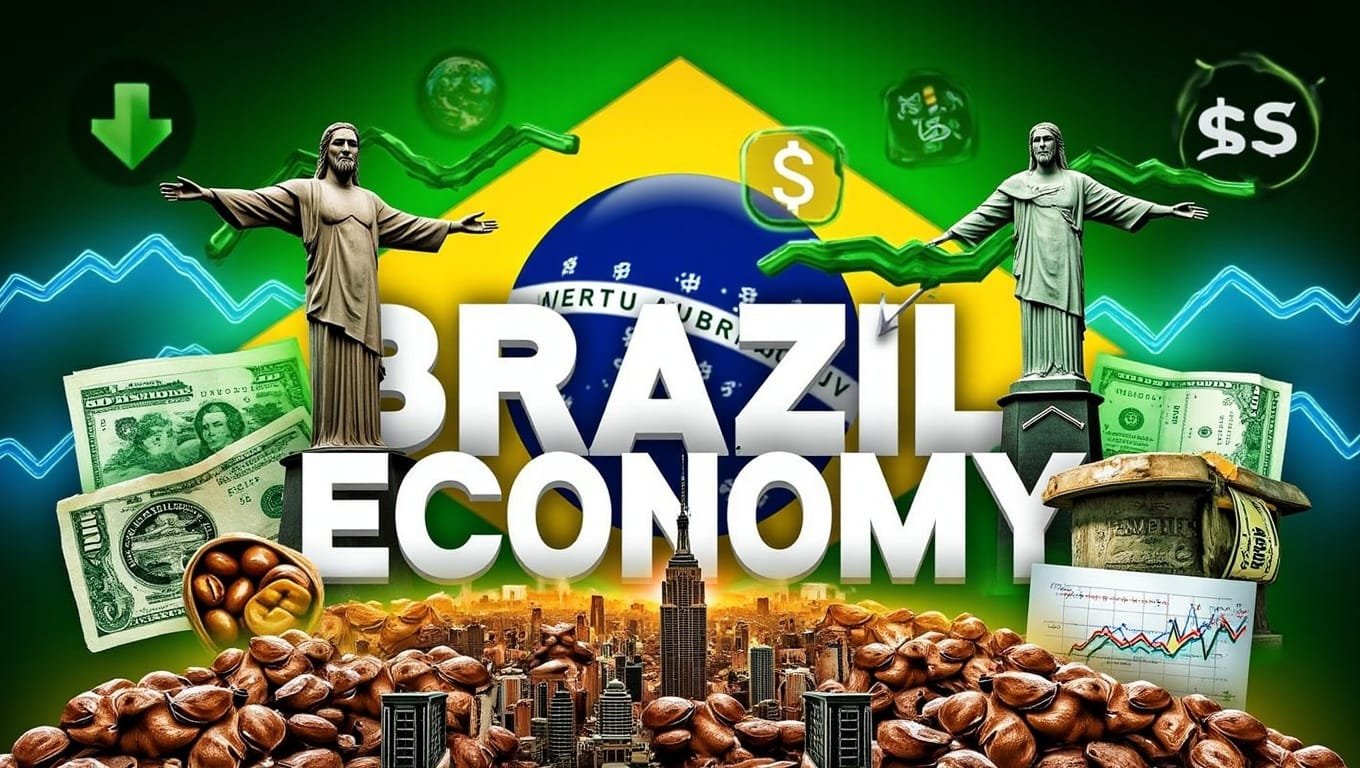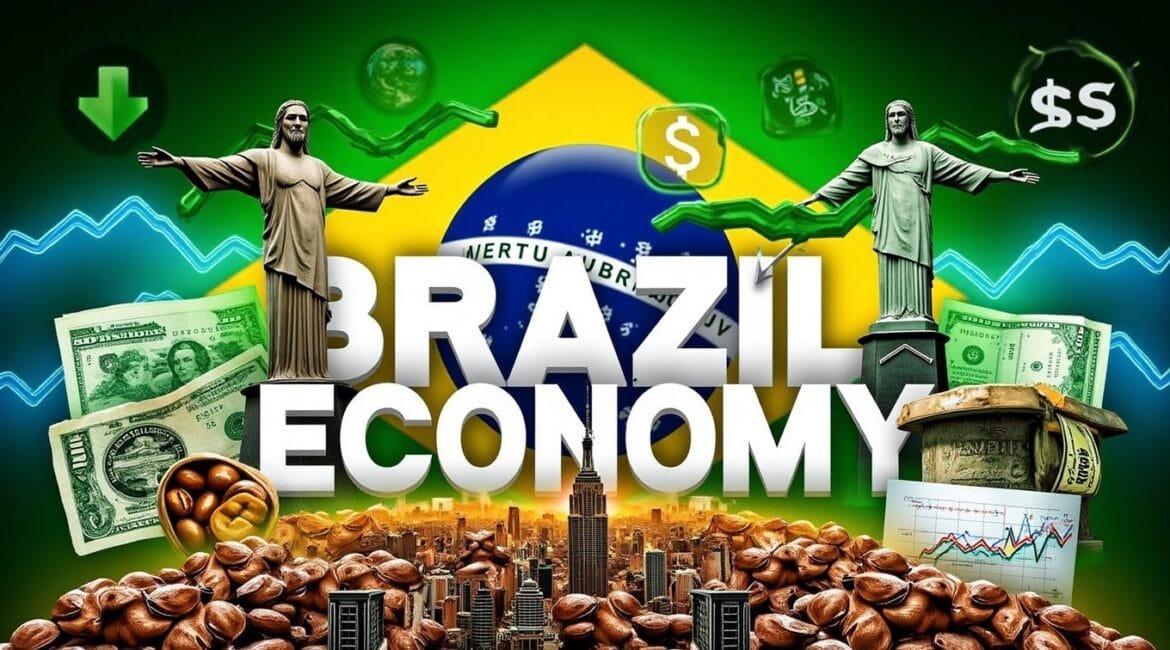The Brazilian Economy stands as a unique blend of immense natural wealth, industrial potential, and global trade integration. As the world’s seventh-largest economy by purchasing power parity (PPP), Brazil plays a significant role on the international stage. But how does this economy balance its vast opportunities with challenges such as inflation, public debt, and environmental concerns? This comprehensive analysis explores Brazil’s historical economic evolution, key sectors driving growth, challenges, and the strategies it employs to secure its position as a global economic powerhouse.
The Evolution of the Brazilian Economy 
From Colony to Rising Power
Brazil’s economic journey began during its colonial era, marked by heavy reliance on sugarcane exports, which later shifted to coffee production in the 19th and early 20th centuries. These industries laid the foundation for Brazil’s agricultural dominance, which continues to play a vital role in its economy today.
Industrialization gained momentum in the mid-20th century, with significant development in steel production, automobiles, and consumer goods. However, structural challenges, such as inequality and inconsistent economic policies, limited further progress.
The “Economic Miracle” (1968–1973)
During this period, Brazil experienced rapid economic growth, with annual GDP increases averaging 10%. This growth was fueled by government-led industrialization and foreign investments, which laid the groundwork for its industrial sectors. However, this era also saw a rise in public debt, creating long-term fiscal challenges.
Key Sectors Driving the Brazilian Economy 
Agriculture: The Backbone of the Economy
Brazil is a global agricultural powerhouse, ranking among the world’s top exporters of soybeans, beef, coffee, and orange juice. Agriculture contributes approximately 27% of Brazil’s GDP, when considering agribusiness and related industries.
Brazil’s adoption of technology and sustainable farming practices has enhanced its productivity and strengthened its role in ensuring global food security.
Energy Sector: A Rising Star
Brazil is a major player in the global energy market, thanks to its vast natural resources. Key highlights include:
- Ethanol Biofuel: Brazil is one of the world’s largest producers of ethanol, derived from sugarcane.
- Offshore Oil Reserves: The discovery of oil in Brazil’s pre-salt fields off the Atlantic coast has positioned the country as a leading oil producer.
- Renewable Energy: Over 80% of Brazil’s electricity comes from renewable sources, including hydropower and wind energy.
Industry and Production
Brazil’s industrial sector is diverse, producing automobiles, steel, and textiles, among other goods. São Paulo serves as the country’s financial and industrial hub, driving much of its economic activity. However, global competition and domestic economic instability have presented challenges for the sector.
Challenges Facing the Brazilian Economy 
1. Public Debt
Brazil’s public debt has exceeded 90% of GDP, raising concerns about fiscal stability. High spending on social programs and infrastructure projects often outpaces revenue, creating persistent budget deficits. Efforts to reduce debt, such as pension reform and privatization, have faced political resistance.
2. Inflation and Currency Volatility
Inflation has been a chronic issue in Brazil, often exacerbated by external shocks and policy mismanagement. While inflation has stabilized in recent years, the volatility of the Brazilian real continues to affect trade and investment decisions.
3. Inequality and Poverty
Despite significant poverty reduction efforts, Brazil remains one of the most unequal countries globally. Income inequality is particularly pronounced in rural areas and among marginalized communities, limiting access to education, healthcare, and economic opportunities.
Brazil in the Global Economy 
Trade and Exports
Brazil is heavily integrated into global trade, with exports accounting for nearly 25% of its GDP. Key statistics include:
- Exports in 2024: $335 billion
- Top Trading Partners: China, the United States, and Argentina
- Major Commodities Exported: Iron ore, soybeans, and crude oil
Membership in BRICS
As a founding member of BRICS (Brazil, Russia, India, China, and South Africa), Brazil plays a pivotal role in fostering economic cooperation among emerging markets. The New Development Bank (NDB), established by BRICS, funds critical infrastructure projects that support sustainability and development.
Technological Innovations in Brazil 
The Fintech Revolution
Brazil is leading the fintech revolution in Latin America, with companies like Nubank and PicPay transforming financial services. The Central Bank of Brazil’s PIX system, an instant payment platform, has accelerated financial inclusion, providing banking access to millions.
Agritech Innovations
In the agricultural sector, Brazil is leveraging technology to enhance productivity. Innovations include:
- Precision farming
- Drone surveillance
- AI-driven crop monitoring
These advancements are helping farmers increase yields while promoting environmental sustainability.
Future Outlook for the Brazilian Economy 
Investments in Infrastructure
The Brazilian government views infrastructure development as a cornerstone for economic growth. Priority areas include:
- Transportation
- Energy
- Telecommunications
Public-private partnerships (PPPs) are playing a key role in funding these initiatives.
Green Economy Opportunities
Brazil’s commitment to sustainability and renewable energy positions it as a global leader in the green economy. Efforts to protect the Amazon rainforest and invest in solar and wind energy highlight the country’s potential for green growth.
Conclusion 
The Brazilian Economy is a dynamic and complex system, shaped by its natural wealth, industrial potential, and global trade connections. While challenges like public debt, income inequality, and inflation persist, Brazil’s resilience and adaptability offer hope for sustained growth.
With strategic investments in infrastructure, renewable energy, and technological innovation, Brazil is poised to solidify its position as a leading global economy. As it navigates the balance between challenges and opportunities, the Brazilian economy remains a critical case study for scholars and policymakers interested in emerging markets and sustainable development.
Frequently Asked Questions 
1. Which industries contribute the most to the Brazilian economy?
Key industries include agriculture, energy, and services, with agriculture accounting for a significant share of exports.
2. Why is Brazil important in global trade?
Brazil is a major exporter of commodities like soybeans and iron ore, making it a vital player in international trade.
3. What are the challenges facing Brazil’s economy?
Major challenges include public debt, income inequality, and currency volatility, which affect economic stability and growth.
4. How does Brazil lead in renewable energy?
Brazil generates over 80% of its electricity from renewable sources, including hydropower, wind energy, and biofuel.
5. What is Brazil’s role in BRICS?
As a BRICS member, Brazil collaborates with other emerging markets to drive sustainable development and infrastructure investments.
This article is intended solely for educational purposes and provides general information. It should not be interpreted as financial, investment, or any other form of personalized advice. The author assumes no responsibility for any decisions, actions, or outcomes resulting from the use of the information provided in this article. It is recommended that the reader consult a qualified professional before making any financial or investment decisions.
The images used on this site are sourced from free image banks such as Pixabay, Freepik, and Pexels. Additionally, some images and textual content may be generated or assisted by artificial intelligence tools. While the author makes every effort to ensure the accuracy and quality of the provided information, there is no guarantee of financial or other benefits resulting from the application of this information. The use of this content is solely the responsibility of the reader.
The author also assumes no responsibility for inaccuracies or any distortions caused by the use of artificial intelligence in the generation of content, whether textual or visual. It is always recommended that the reader seek guidance from a qualified professional to validate and interpret the information contained in this article.


